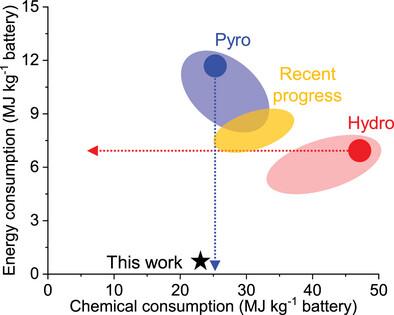Thermal Runaway Induced Battery Recycling
IF 26
1区 材料科学
Q1 CHEMISTRY, PHYSICAL
引用次数: 0
Abstract
Elemental extraction from spent lithium-ion batteries (LIBs) is considered the most mature and inevitable recycling route. However, industrial hydrometallurgy (Hydro) and pyrometallurgy (Pyro) strategies necessitate complex processes with high energy and chemical consumption, leading to significant environmental impacts and reduced profitability. Here, a strategy for low-consumption recycling of spent LIBs using the batteries’ intrinsic energy through thermal runaway is presented. Direct thermal runaway heats the battery to promote cathode thermal reduction, thereby changing the thermodynamics and sluggish kinetics of element extraction. Taking LiMn0.64Ni0.29Co0.07O2 batteries as an example, thermal runaway battery recycling can save at least 37.9% and 55.7%, respectively, in energy and chemical consumption compared to Pyro and Hydro, and can reduce greenhouse gas emissions by 54.6% and 44.5%, respectively. This results in a profit of 1.94 $ kg−1 battery, which is comparatively higher than the 1.14 $ kg−1 for Hydro and 0.79 $ kg−1 for Pyro recovery strategies.

热失控引起的电池回收
从废锂离子电池中提取元素被认为是最成熟、最不可避免的回收途径。然而,工业湿法冶金(Hydro)和火法冶金(Pyro)战略需要复杂的过程,能源和化学消耗高,导致重大的环境影响和降低盈利能力。本文提出了一种利用电池固有能量通过热失控实现废旧锂电池低消耗回收的策略。直接热失控加热电池,促进阴极热还原,从而改变元素提取的热力学和缓慢动力学。以LiMn0.64Ni0.29Co0.07O2电池为例,与Pyro和Hydro相比,热失控电池回收可以分别节省至少37.9%和55.7%的能源和化学品消耗,可以分别减少54.6%和44.5%的温室气体排放。这导致1.94 $ kg - 1电池的利润,相对高于1.14 $ kg - 1的Hydro和0.79 $ kg - 1的Pyro回收策略。
本文章由计算机程序翻译,如有差异,请以英文原文为准。
求助全文
约1分钟内获得全文
求助全文
来源期刊

Advanced Energy Materials
CHEMISTRY, PHYSICAL-ENERGY & FUELS
CiteScore
41.90
自引率
4.00%
发文量
889
审稿时长
1.4 months
期刊介绍:
Established in 2011, Advanced Energy Materials is an international, interdisciplinary, English-language journal that focuses on materials used in energy harvesting, conversion, and storage. It is regarded as a top-quality journal alongside Advanced Materials, Advanced Functional Materials, and Small.
With a 2022 Impact Factor of 27.8, Advanced Energy Materials is considered a prime source for the best energy-related research. The journal covers a wide range of topics in energy-related research, including organic and inorganic photovoltaics, batteries and supercapacitors, fuel cells, hydrogen generation and storage, thermoelectrics, water splitting and photocatalysis, solar fuels and thermosolar power, magnetocalorics, and piezoelectronics.
The readership of Advanced Energy Materials includes materials scientists, chemists, physicists, and engineers in both academia and industry. The journal is indexed in various databases and collections, such as Advanced Technologies & Aerospace Database, FIZ Karlsruhe, INSPEC (IET), Science Citation Index Expanded, Technology Collection, and Web of Science, among others.
 求助内容:
求助内容: 应助结果提醒方式:
应助结果提醒方式:


